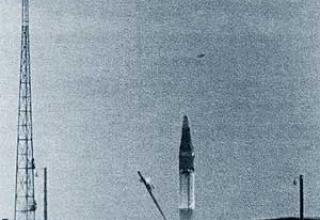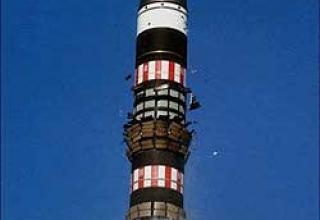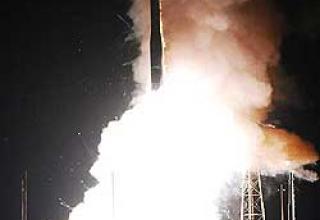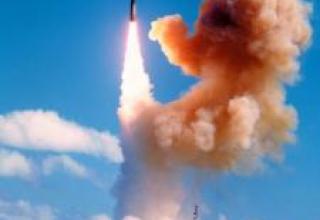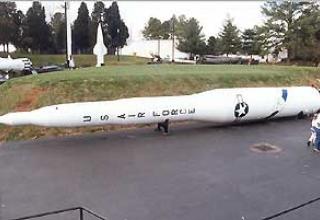By a decree of the USSR Government dated May 12, 1962, Yuzhnoye Design Bureau was assigned to create a strategic missile system R-36 with a "heavy" class missile capable of delivering a super-powerful thermonuclear charge. The new 8K67 second-generation missile was designed to defeat enemy objects protected by a powerful missile defense system. The specifications provided for the development of the missile in two versions: with ground (which was later abandoned) and with a mine start. During the design process the design solutions and technologies worked out on 8K64 (R-16) missile were widely used.
Development of 8K67 was carried out at an accelerated pace and at the end of May 1966 was completed the entire cycle of tests, and July 21, 1967 rocket system R-36 was adopted by the Strategic Missile Forces. November 5, 1966 in the city of Uzhur began putting on combat duty the first missile regiment with missiles of this type.
Almost immediately after the completion of tests of missile 8K67 (in December 1967) Yuzhnoye DO began to develop a missile with a splitting head unit (RSH) on the basis of 8K67. The peculiarity of creating a new version of the missile, which received the designation 8K67P, was that its development was carried out in an extremely short time. The requirement to accelerate the development of the RSH was due to the fact that at the same time the US was developing the RSH for the Minuteman missile and the USSR should not lag behind. At the same time, the design of the RSH was developed taking into account the requirement to ensure the re-equipment of 8K67 missiles on combat duty in powered silo boosters without taking them out of the boosters, minimizing improvements to the boosters and ground verification and launch equipment.
The 8K67P rocket with a split HC as part of the R-36 missile was adopted for service in 1970 and was placed on active duty in 1971.
R-36 complex with 8K67P missile was taken out of service in 1978, with 8K67P missile - in 1979.
In the west the complex received the designation SS-9 "Scarp".
Composition:
Two-stage 8K67 is made on the scheme "tandem" with consecutive separation of steps. The first stage provides missile acceleration. It consists of an adapter, an oxidizer tank, an instrument compartment, a fuel tank and a tail compartment. The first stage was equipped with a marching engine RD-251 (8D723), consisting of three two-chamber modules RD-250, as well as the steering engine RD-68M with four rotary combustion chambers and had a thrust on the ground 274 tons. The tail compartment is equipped with four brake-powder rocket engines, triggered at the separation of the second stage.
The second stage provides acceleration to the speed corresponding to the specified range of fire and consists of instrument, fuel and tail compartments. Fuel tanks have a combined bottom and are carried out according to the carrier scheme. The second stage is equipped with the RD-252 two-chamber marching engine and RD-69M four-chamber steering gear. The engines have a high degree of unification with the engines of the first stage. To supply all LRDs, a two-component self-ignition fuel is used: oxidizer - nitrogen tetraoxide (AT), fuel - NDMG. All tanks are inflated with combustion products from the main fuel components. At each stage, to reduce the guaranteed reserves of fuel, has its own system of simultaneous emptying of tanks.
The rocket was developed with two types of control system: combined with a radio-correction channel and a purely inertial one. However, during the flight tests the combined control system was abandoned because the inertial control system fully provided the specified accuracy of firing. This resulted in a significant reduction in the cost of production and deployment. The elements of the control system were located in the instrument compartments of the first and second stages.
One of the serious problems solved during the development and testing of this missile was the problem of ensuring a high degree of tightness of the fuel systems in order to meet the requirement for seven years of storage in a refueled state.
The following new technical solutions were introduced on the 8K67 missile:
- Two monoblock GCs with the most powerful of the combat charges tested by that time and a complex of countermeasures to the ABM system of the probable enemy were developed and applied;
- an autonomous control system has been developed that provides automatic remote prelaunch preparation for the launch and launch of the missile from the slide control system with the subsequent (after the missile leaves the mine) pointing of the missile at the azimuth target by turning it into the firing plane (the turning start table at the start is excluded), high combat readiness and firing accuracy as compared with the previous missiles;
- a new more energy-efficient oxidizer, nitrogen tetroxide, has been used;
- on Stage II, the fuel components are placed in a single fuel cell divided into oxidizer cavities and a fuel intermediate bottom (for the first time, the principle of dense layout of missile compartments has been implemented);
- in the design of fuel tanks used pressed chemically milled panels and hollow bends made of pressed profiles, which significantly reduced the weight of the compartments and simplified the technology of their manufacture;
- in the fuel cavity of Stage II a tunnel pipe is excluded, and the oxidizer line is made of a fully pressed pipe with spiral bellows welded to it;
- "hot" injection of fuel tanks with the help of special gas generators working on the main fuel components selected from the power supply system of stage steering engines;
- to exclude the period of weightlessness, the stage II marshal engine shall be started when the stage steering engine is started beforehand;
- Improved performance of the rocket in the fuel-fuelled state is ensured by amputation of the rocket structure and its fuel system;
- increased invulnerability of missiles at launch through the dispersal of launchers.
A characteristic feature of the autonomous SC rocket was that, in order to increase the missile's combat readiness, it was planned to accelerate the acceleration of gyroscopes of gyroblocks and gyrointegrators by supplying increased power supply voltage to gyro motors. The SU was developed by OKB-692, and the command devices of the SU were developed by Research Institute-944.
The combat equipment of 8K67 missile was developed:
- monoblock HF with a "heavy" class UA with 20Mt of charge (see photo);
- monoblock HF with the "light" class UA with the charge capacity of 8Mt (see photo1, photo2, photo3);
- the system of radio technical protection of the MS (the "List" system)
Both stages of the missile were equipped with simultaneous tank emptying systems, reducing warranty stocks and fuel component residues. The filling of tanks with fuel components was controlled by the level control system. The following systems were also installed on the missile: emergency blast for liquidation of the MS in case of deviations of the rocket motion parameters on the AUT exceeding the admissible ones, remote control of gas contamination of the rocket compartments by the vapor of the fuel components, protection of the tanks from vacuum and excess pressure. For separation of stages and separation of the MS on the I and II stages brake powder engines were installed.
The rocket is launched from the launch table, installed in the control panel. Launch of the rocket from the PU - gas-dynamic with the launch of the first stage of the remote control directly in the launcher. Shockless rocket output from the PU was provided by the movement of the rocket on rails in one diametric plane of the starting cup. Rocket sliding on guides was provided by the rods fixed on the I stage of the rocket. After the exit of the missile from the NC the rods were dropped. The launch table was a slippery slope, had no azimuthal guidance devices and mechanisms. The gas flow from the operating remote control of the I stage was diverted by means of a gas flow splitter installed in the lower part of the PC to the gas removal devices located along the barrel of the launch table and in the shaft head in one diametric plane.
The DBK consisted of six dispersed combat launch positions, each of which housed single mine PCs. Close to one of them was a MRBM command post connected by the lines of combat control and communication system with all launch positions. The level of protection of the MRBM against a shock wave of Java was as follows: 2 kgf/cm2 SSR; 10 kgf/cm2 control point. The SLE consisted of a headband and a vertical trunk with the lower part of the shaft. The PU was covered with a special protective device (roof) of a sliding type, which provided sealing of the shaft and protection of the missile from the damaging factors of AB. The capsule housed power supplies, equipment and equipment of technological and technical systems. The equipment composition provided long storage of the missile in the fueled state, as well as a remote control with a ballistic missile booster or stand-alone - from each launch position from the booster - to carry out operations to prepare for launch and launch the missile.
Combat application in any weather conditions at air temperatures from - 40 to + 50 ° C and wind speed at the ground surface up to 25 m / s, before and after the nuclear impact on the DBK.
The main difference between the missile 8K67P and 8K67 is its new type of head end - the separable HC 8F676 as part of three BB 8F677 with a capacity of 2.3Mt and KSP PRO. The main power unit of the MGCh was a platform mounted on the missile's OEM instrument compartment. To attach the booster to the platform and their subsequent dilution were used mounting rings with carriages supported by the platform guides. Breeding of the booster was carried out by "rolling" them on the inclined rails with the engine running II stage of the rocket. To reduce aerodynamic drag, the combat units were installed with a slope of 11° to the missile's longitudinal axis, and on the tops of the booster was installed a fairing in the form of a tip of three cones.
Installation of RSH on the missile required modification of the onboard BMD in terms of providing telecommunications between the BMD and RSH. The design of the RFC did not provide individual guidance of each of the three blocks on a separate target. It was possible to target one of the blocks or the center of their grouping. Nevertheless, the use of such a rGCh in countermeasures against the missile defense system increased the combat efficiency of the 8K67P missile by ~2 times compared to the 8KV7 missile.
The composition and structure of the new MRBMs remained the same as that of the 8K67s. The ground operation of the MRBM required improvement of the ground verification launch equipment and the technical position of the MRBM in terms of construction of the MRBM assembly hull, creation of an isothermal transport unit for transportation of the MRBM.
Characteristics:
| General characteristics | |
| Maximum range of fire, km: - Heavy class. - Light Class HC |
10200 15200 |
| Firing accuracy, km | ±5 |
| Generalized reliability indicator | 0.95 |
| Launch time from full alert, mines. | 4 |
| Warranty period on combat duty under the regulations once every 2 years, years | 7 |
| 8K67 missile | |
| The starting weight of the rocket, shh: - with HF heavy class - with a light class HF |
183.9 182.0 |
| Weight of the head end (Heavy class MS / Light class MS), kgf | 5825/3950 |
| Weight of the combat unit (Heavy class MS / Light class MS), kgf | 4560/2852 |
| Weight of anti-missile defense systems, kgf | 272 |
| Weight of fuel, shh: - Stairs I - II stages |
118.9 48.5 |
| Length of "heavy" class HC, m. | 32.2 |
| Diameter, m | 3 |
| Characteristics of stage I remote control: - thrust (on the ground/in the void), tc - specific impulse (on the ground/in the void), s - combustion chamber pressure, kgf/cm2 |
270.3/303.2 267.8/300.3 85 |
| Characteristics of stage II remote control: - thrust in the void, tc - specific pulse in the void, s - combustion chamber pressure, kgf/cm2 |
101.5 315.3 91 |
| Flight Reliability | 0.956 |
| Energy Performance Coefficient (with "heavy" class PPP) Snr/yo, kgs/ts | 31.8 |
| 8K67P rocket | |
| Launch weight of the rocket,tc | 183.45 |
| Weight of the head end,kgf | 5440 |
| Weight of military equipment, kgf | 3х1425 |
| Weight of anti-missile defense systems, kgf | 401 |
| Flight Reliability | 0.954 |
| Energy/coefficient of perfection, kgs/ts | 29.5 |
Testing:
SLBMs and 8K67 missiles were tested at 5 NIIPs. The first launch of the missile was held on September 28, 1963, and ended LKI in May 1966. During this period, 85 launches were conducted, of which -14 failures, 7 of which fall on the first 10 launches. In total, 146 launches of all modifications of the missile were made. The first three launches of the missile were made from the launch pad of the open launch position, the subsequent ones - from the slide control system. The first launch did not take place because the rocket caught fire on the launch pad because of improperly designed gas exhaust channels of the launch pad.
The development of CDBs with 8K67P missiles with RSH also took place at 5 NIIP. The first launch of the 8K67P with the 8K677BM was in August 1968, and four more successful experimental launches were made by the end of 1968. The 8K67P with the 8K677BM began in 1969 and were completed in 1970, including launches to the Aquatoria area.
Sources:
- "Призваны временем. Ракеты и космические аппараты конструкторского бюро "Южное"./ Под общей редакцией С.Н.Конюхова/. Д.: Арт-Пресс, 2004,-232с.
- "КБ специального машиностроения: От артиллерийских систем до стартовых комплексов" (под редакцией Ушакова В.С.) .СПб, 2004.
- Карпенко А.В., Уткин А.Ф., Попов А.Д. "Отечественные стратегические ракетные комплексы". СПб, Невский бастион-Гангут 1999 год.
- https://photos.google.com/share/AF1QipPNkXej_BwL0KnGdfujgpOX6KwevWGk4DpHcRQ74zaf7I-qUGs_M3jybe48FZHPCQ/photo/AF1QipMq9i18mxQ01rR_5E5M4f18WiLYU2pL2dj2CccY?key=bnFYQnRSbVRuX2tWNTUybndzbEhTTDRMZzFoMXpR




